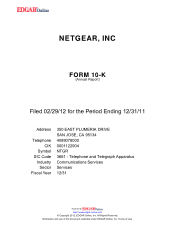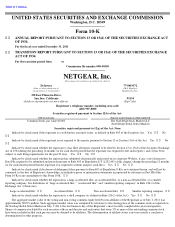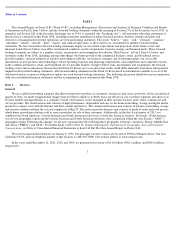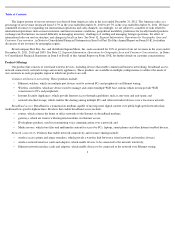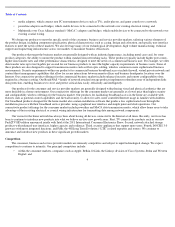Netgear 2011 Annual Report Download - page 10
Download and view the complete annual report
Please find page 10 of the 2011 Netgear annual report below. You can navigate through the pages in the report by either clicking on the pages listed below, or by using the keyword search tool below to find specific information within the annual report.
Table of Contents
We identify, qualify or self-develop new technologies, and we work closely with our various technology suppliers and manufacturing
partners to develop products using one or more of the development methodologies described below.
ODM. Under the original design manufacturer (“ODM”), methodology, we define the product concept and specification and recommend
the technology selection. We then coordinate with our technology suppliers while they develop the product meeting our specification. On certain
new products, one or more subsystems of the design can be done in-house and then integrated in with the remaining design pieces from the
ODM. Once prototypes are completed, we work with our partners to complete the debugging and systems integration and testing. After
completion of the final tests, agency approvals and product documentation, the product is released for production.
In-House Development. Under the in-house development model, one or more subsystems of the product are designed and developed
utilizing the NEGEAR engineering team. Under this model, some of the primary technology is developed in-house. We then work closely with
either an ODM or a contract manufacturer to complete the development of the entire design, perform the necessary testing, and obtain regulatory
approvals before the product is released for production.
OEM. Under the original equipment manufacturer (“OEM”), methodology, which we use for a limited number of products, we define the
product specification and then purchase the product from OEM suppliers that have existing products fitting our design requirements. In some
cases, once a technology supplier’s product is selected, we work with the OEM supplier to complete the cosmetic changes to fit into our
mechanical and packaging design, as well as our documentation and graphical user interface (“GUI”), standard. The OEM supplier completes
regulatory approvals on our behalf. When all design verification and regulatory testing is completed, the product is released for production.
Our internal research and development efforts focus on developing and improving the usability, reliability, functionality, cost and
performance of our products. Our total research and development expenses were $48.7 million in 2011, $40.0 million in 2010 and $30.1 million
in 2009.
Manufacturing
Our primary manufacturers are Cameo Communications Inc., Delta Networks Incorporated, Hon Hai Precision Industry Co., Ltd. (more
commonly known as Foxconn Corporation), SerComm Corporation, and Unihan Corporation (which was spun out of ASUSTek Computer, Inc.
in January 2008), all of which are headquartered in Taiwan. The actual manufacturing of our products occurs primarily in mainland China and
Vietnam, with pilot and low-volume manufacturing in Taiwan on a select basis. We distribute our manufacturing among these key suppliers to
avoid excessive concentration with a single supplier. Because substantially all of our manufacturing occurs in mainland China and Vietnam, any
disruptions from natural disasters, health epidemics and political, social and economic instability would affect the ability of our ODMs to
manufacture our products. In addition, our ODMs in China have continued to increase our costs of production, particularly in the recent year.
These increased costs have affected our margins and ability to lower prices for our products to stay competitive. If our manufacturers or
warehousing facilities are disrupted or destroyed, we would have no other readily available alternatives for manufacturing our products and our
business would be significantly impacted. In addition to their responsibility for the manufacturing of our products, our manufacturers purchase
all necessary parts and materials to produce complete, finished goods. To maintain quality standards for our suppliers, we have established our
own product quality organization based in Hong Kong and mainland China. They are responsible for auditing and inspecting process and product
quality on the premises of our ODMs and OEMs.
We obtain several key components from limited or sole sources. For example, many of the semiconductors and meta materials used in our
products are designed for use in our products and are obtained from sole source suppliers on a purchase order basis. In addition, some
components that are used in all our products are obtained
6

